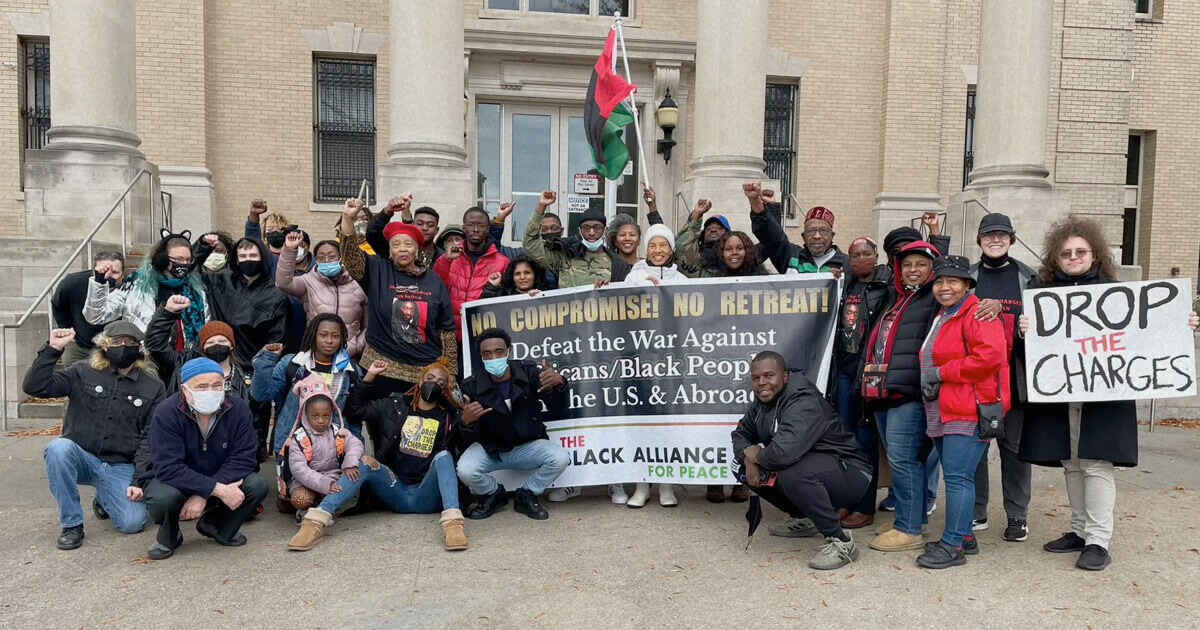The U.S. Congress last tried to grapple with what the country’s ballooning security services were up to nearly half a century ago.
In 1975, the Church Committee managed to take a fleeting, if far from complete, snapshot of the netherworld in which agencies such as the Central Intelligence Agency (CIA), Federal Bureau of Investigations (FBI) and National Security Agency (NSA) operate.
In the aftermath of the Watergate scandal, the congressional committee and other related investigations found that the country’s intelligence services had sweeping surveillance powers and were involved in a raft of illegal or unconstitutional acts.
They were covertly subverting and assassinating foreign leaders. They had coopted hundreds of journalists and many media outlets around the world to promote false narratives. They spied on and infiltrated political and civil rights groups. And they manipulated the public discourse to protect and expand their powers.
Senator Frank Church himself warned that the might of the intelligence community could at any moment “be turned around on the American people, and no American would have any privacy left, such is the capability to monitor everything… There would be no place to hide.”
Since then, the technological possibilities to invade privacy have dramatically increased, and the reach of the intelligence agencies, especially after 9/11, has moved on in ways Church could never have foreseen.
This is why establishing a new Church Committee is long overdue. And finally, in the most controversial of circumstances and for the most partisan of reasons, some sort of revival may finally be about to happen.
A protracted battle last month within the Republican Party to elect Kevin McCarthy as the new speaker of the House of Representatives forced him to cave to the demands of his party’s right wing. Not least, he agreed to set up a committee on what is being called the “weaponisation” of the federal government.
It held its first meeting last week. The panel said its task would be to look at “the politicization of the FBI and DOJ and attacks on American civil liberties”.
Earlier, in a speech to the House on the new committee, Republican Representative Dan Bishop said it was time to cut out the “rot” in the federal government: “We’re putting the deep state on notice. We’re coming for you.”
Democrats are already decrying the committee as a tool that will be wielded in the interests of Donald Trump and his supporters, saying the Republican right wants to discredit the security services and suggest malfeasance in the treatment of the former president.
Snowballing powers
But while the committee will almost certainly end up being used to settle political scores, it may still manage to shed light on some of the terrifying new powers the security services have accrued since the Church Committee’s report.
The degree to which those powers have snowballed should be obvious to all. Documents leaked by whistleblower Edward Snowden a decade ago showed illegal mass surveillance at home and abroad by the NSA. And Julian Assange’s transparency organisation Wikileaks published dossiers not only revealing U.S. war crimes in Iraq and Afghanistan, but a huge global hacking programme by the CIA.
Notably, in what may be a sign of the power of the security agencies to inflict retribution on those challenging their might, both Assange and Snowden have suffered dire consequences.
Snowden has been forced into exile in Russia, one of the few jurisdictions where he cannot be extradited to the U.S. and locked away. Assange has been jailed as U.S. authorities seek his extradition, so he can be disappeared into a maximum-security prison for the rest of his life.
Now, in an unlikely turn of events, a billionaire has opened another window on covert manipulations by the security services—on this occasion in relation to social media platforms and the U.S. electoral process. The key players this time are the FBI and the Department of Homeland Security (DHS), set up by former President George W Bush’s administration in the wake of the 9/11 attacks.
After he bought the social network Twitter last year, Elon Musk gave a handful of independent journalists access to its corporate archives. In a continuing series of investigations named the Twitter Files, published as long threads on the platform, these journalists have been making sense of what was going on under Twitter’s previous owners.
The bottom line is that, after Trump’s election, U.S. security agencies—aided by political pressure, especially from the Democratic Party—aggressively wormed their way into Twitter’s decision-making processes. Other major social media platforms appear to have made similar arrangements.
A ‘nothingburger’?
The Twitter Files suggest a rapidly emerging but hidden partnership between state intelligence services, Silicon Valley, and traditional media, to manipulate the national conversation in the U.S.—as well as much of the rest of the world.
The parties in this alliance justify to each other their meddling in U.S. politics—concealed from public view—as a necessary response to the rapid rise of a new populism. Trump and his supporters had come to dominate the Republican Party, and a populist left headed by Senator Bernie Sanders had made limited inroads into the Democratic Party.
Social media attracted particular concern from the security services because it was seen as the vehicle that had unleashed this wave of popular discontent. According to a report in the Intercept, one FBI official remarked last year that “subversive information on social media could undermine support for the U.S. government”.
The national security state, it seems, viewed an alliance with the Big Tech private sector as an opportunity to protect the old guard of politics, particularly in the Democratic Party. Figures such as President Joe Biden and former House Speaker Nancy Pelosi were seen as a safe pair of hands, positioned to preserve the legitimacy of a turbo-charged, neoliberal capitalism, and the forever wars that have been the lifeblood of the intelligence community.
This partnership has served all sides well. Silicon Valley has been the career of choice for many liberals who believe that progress is best pursued through technological means that depend on social stability and political consensus. Populism and the polarisation it engenders naturally discomfort them.
And both the security services and more centrist politicians in the Republican and Democratic parties understand that they are in the firing line in populist politics for decades-long failures: a growing polarisation of wealth between rich and poor, a creaking US economy, depleted or non-existent welfare services, the ability of the rich to buy political influence, the constant loss of treasure and life in seemingly pointless wars fought in far-off lands, and a media that rarely addresses the concerns of ordinary people.
Rather than focusing on the real causes of growing anger and anti-establishment sentiment, the security services offered politicians and Silicon Valley a more comforting and convenient narrative. The populists—on the right and left—were not articulating a frustration with a failing U.S. political and economic system. They were working to sow social discontent to advance the interests of Russia.
Or as the minutes of a DHS meeting last March recorded, the new focus was on curbing “subversive data utilized to drive a wedge between the populace and the government”.
This strategy reached its zenith with “Russiagate”, years of evidence-free hysteria promoted by the intelligence community and the Democratic Party. The central claim was that Trump was only able to defeat his Democratic rival Hillary Clinton in the 2016 presidential election because of collusion with Moscow, and Russian influence operations through social media.
As in a game of whack-a-mole, any signs of misconduct or criminality by the security services, or systemic failures by the U.S. political class, were now knocked down as “Russian disinformation”.
Snowden’s exile to Russia—the only choice left to him—was used to discredit his whistleblowing on the NSA. And the disclosures by Assange and Wikileaks of war crimes and lawbreaking by the intelligence community were effectively negated by a supposed collusion with “Russian hackers” in revealing corruption in the Democratic Party during the 2016 election.
In practice, claims of “Russian disinformation” simply served to further polarise U.S. politics.
The key issues raised by the Twitter Files—of deep-state collusion with the tech and media industries, election meddling, and narrative manipulation and deflection—have been subsumed within, and obscured by, political partisanship.
Interest in the Twitter Files has been largely confined to the right. In knee-jerk fashion, Democrats have mostly dismissed the revelations as a “nothingburger”.
Climate of fear
Perhaps coincidentally, Musk has found himself transformed since his takeover of Twitter from a darling of liberals—for his Tesla electric cars—into a near-pariah. In October, the Biden administration denied reports that it was considering a national security review of his businesses in the face of Musk’s “increasingly Russia-friendly stance”. His status as the world’s richest man has rapidly collapsed alongside his reputation.
The irony is that the same security agencies that whipped up the “Russiagate” hysteria are now exposed in the Twitter Files as perpetrating the very interference of which they accused Moscow.
During the 2016 presidential election, Russia was said to have colluded with Trump and assisted him by weaponising social media to sow discord and manipulate the U.S. electorate. A subsequent official inquiry by Robert Mueller failed to stand up those allegations.
2. What you’re about to read is the first installment in a series, based upon thousands of internal documents obtained by sources at Twitter.
— Matt Taibbi (@mtaibbi) December 2, 2022
Instead, the Twitter Files indicate that it was not Russia but the FBI, DHS and CIA—the very agencies arguing that Russia threatened political order in the U.S.—that were aggressively and clandestinely seeking to influence American public opinion.
The Twitter Files suggest that it is the U.S. security state, much more than Russia, that poses the real menace to U.S. democracy. The climate of fear these agencies fuelled over supposed “Russian disinformation” not only swayed public opinion, but gave the intelligence community even greater leverage over social media networks and further licence to accumulate greater powers.
State actors are increasingly in charge of deciding who is allowed to be heard on social media—even Trump was banned while president—and what can be said. Those decisions are often taken not to prevent a crime or enforce laws, or even for the public good, but to tightly control political discourse to marginalise serious criticism of the establishment.
The fact that the collusion between social media platforms and these agencies has taken place in secret is itself an indication of the nefarious nature of what’s been going on.
Hidden pressure
The Twitter Files open a window on a phenomenon that appears to have been playing out across all social networks.
Traditionally, liberals have defended social media’s use of censorship on the grounds that these platforms are private companies that can do as they please. Their behaviour supposedly does not constitute a violation of First Amendment protections of free speech.
The reality exposed by the Twitter Files, however, is that the networks have often been responding to hidden pressure, either directly from the federal government or via its intelligence agencies, in restricting what can be said. As the Files have repeatedly noted, Twitter, like other social media, has come to function less as a private company and more as “a kind of subsidiary of the FBI”.
In 2017, at the height of the Russiagate panic, the FBI set up a Foreign Influence Task Force whose numbers soon swelled to 80 agents. Its ostensible job was to liaise with the various networks to stop alleged foreign interference in elections.
Twitter executives were soon meeting and communicating with senior FBI officials on a regular basis, while receiving an endless stream of demands for content takedowns to prevent “Russian disinformation”. The CIA appears to have attended meetings too, under the moniker of OGA or “other government agency”. Although the task force’s remit was foreign influence, it reportedly became a “conduit for mountains of domestic moderation requests, from state governments, even local police”.
Under growing pressure behind the scenes from the intelligence services, and in public from politicians, the social networks started to draw up secret blacklists, aided by information from the security services, to limit the reach of accounts or stop topics trending. The effects were often hard to miss, with Trump declaring he would investigate the practice in 2018.
In response, Twitter executives publicly denied that they practised “shadow banning”—a term for when posts or accounts are made difficult or impossible to find. In fact, Twitter had simply invented a different phrase for the exact same regime of speech suppression. They called it “visibility filtering”.
Such censorship was used not only against suspected bot accounts, or those peddling obvious misinformation. Even eminent public figures who had authority to speak on a topic were secretly targeted if they challenged key establishment narratives.
Stanford epidemiologist Jay Bhattacharya, for example, suffered from “visibility filtering” during the Covid-19 pandemic after he criticised lockdowns for inflicting harm on children. He was put on a “trends blacklist”.
Amid recent mass layoffs at Twitter, Middle East Eye was unable to contact the company for comment on these and other allegations made in the Twitter Files. The CIA had not replied by publication time, while the FBI sent a response stating:
The correspondence between the FBI and Twitter show nothing more than examples of our traditional, longstanding and ongoing federal government and private sector engagements … As evidenced in the correspondence, the FBI provides critical information to the private sector in an effort to allow them to protect themselves and their customers.
Other leading doctors who questioned government orthodoxy have also been sidelined by Twitter, the Files found, often under direct pressure from the White House or vaccine company lobbyists.
But the highest-profile casualty of the Twitter censorship regime was Trump himself. He was banned on 8 January 2021, even though staff reportedly agreed behind the scenes that they could not base such a decision on any direct violation of their rules.
Russian ‘influence’
The fallout from Russiagate drew Twitter more deeply into the embrace of the security services. In early 2018, a Republican representative, Devin Nunes, submitted a classified memo to the House Intelligence Committee detailing alleged abuses by the FBI in surveilling a figure connected to Trump.
The FBI relied on the so-called Steele dossier, which had been partly financed by Clinton and the Democratic Party but was initially presented by the media as an independent, intelligence-led inquiry verifying collusion between Trump’s team and Moscow.
News of the memo provoked a storm on social media among Trump supporters, fuelling a viral hashtag: #ReleaseTheMemo. Nunes’s allegations were verified nearly two years later by a Department of Justice inquiry. Nonetheless, at the time, Democratic politicians and the media rushed to ridicule the memo, characterising any demand for its publication as a “Russian influence operation”.
The heat was dialled up on Big Tech. Twitter’s own investigations could not pinpoint any Russian involvement, suggesting that the hashtag was trending organically, driven by VITs—Very Important Tweeters.
6.The Nunes assertions would virtually all be verified in a report by Justice Department Inspector General Michael Horowitz in December 2019. pic.twitter.com/uLFHwbsiJe
— Matt Taibbi (@mtaibbi) January 12, 2023
But Twitter executives were in no mood for a fight. Rather than take on the Democratic Party—and most likely behind it the FBI, concerned by the memo’s revelations—Twitter followed “a slavish pattern of not challenging Russia claims on the record”, noted Matt Taibbi, one of the journalists who worked on the Twitter Files.
Soon, Russia was being blamed by major media outlets for any embarrassing hashtag that went viral, such as #SchumerShutdown, #ParklandShooting and #GunControlNow. As the campaign of Russiagate claims intensified, Twitter came under ever-greater pressure for action. In 2017, it manually examined some 2,700 accounts flagged as potentially suspicious. The vast majority were cleared. Twitter suspended 22 as possible Russian accounts, while a further 179 were found to have “possible links” to those accounts.
Democratic politicians were incensed, apparently relying on intelligence sources to support their claim that social media was overrun with Russian bots. Twitter responded by setting up a “Russia task force” to investigate further, but again found no evidence of a Russian influence campaign. All it identified were a few lone-wolf posters spending limited money on ads.
Nonetheless, Twitter was plunged into a PR crisis, with politicians and establishment media accusing it of inertia. Congress threatened draconian legislation that would starve Twitter of advertising revenue. Twitter’s inability to find Russian influence accounts led to an indictment from Politico: “Twitter deleted data potentially crucial to Russia probes.” Twitter’s original investigation of the 2,700 accounts fuelled outlandish claims in the media that a “new network” of Russian bots had been discovered.
In the midst of this firestorm, Twitter suddenly changed tack, publicly stating that it would remove content “at our sole discretion”—but in truth, it was far worse than that. As Taibbi reported in one of the Twitter Files, the company decided privately to “off-board” anything “identified by the U.S. intelligence community as a state-sponsored entity conducting cyber operations”.
Twitter increasingly found itself besieged. A Twitter File released last month argues that a prominent online lobby called Hamilton 68—with ties to the intelligence community—perpetrated “a scam” about Russian disinformation.
The site elicited endless headlines in the U.S. media after indicating it had uncovered a Russian influence campaign on social media, involving hundreds of users. Media outlets published these claims as proof that the social networks were overrun with Russian bots. Hamilton 68’s staff were even invited to testify before senior congressional politicians.
Despite this furore, however, Hamilton 68 never made public the list of bots it said it had unearthed. Internal Twitter investigations revealed that almost all of those on the list were ordinary users.
The Alliance for Securing Democracy (ASD), which hosted Hamilton 68 and its successor Hamilton 2.0, issued a “fact sheet” in response to the Twitter Files denying the allegations, and suggesting that its data had been “consistently misunderstood or misrepresented” by the media and lawmakers, despite “extensive efforts to correct misconceptions at the time”. The ASD noted that it never suggested all the bots were Russian, but it was monitoring some that might have been.
Notably, Hamilton 68 was headed by a former senior FBI official. Twitter executives did not publicly stand up to the media pile-on, and found themselves given the brush-off when they tried to raise their concerns privately with reporters.
FBI ‘belly button’
In a sign of how close the relationship between the FBI and Twitter had grown, Twitter recruited as legal counsel James Baker, the FBI’s former top lawyer. Baker had been one of the central figures in the efforts to paint a picture—again now discredited—of collusion between Trump and Moscow.
Plenty of others who left the FBI headed straight to Twitter. They included Dawn Burton, the former deputy chief of staff to FBI head James Comey, who initiated the Russiagate investigation. She became Twitter’s director of strategy in 2019.
Similar ties existed with the British security services. Twitter recruited Gordon MacMillan as its top editorial adviser on the Middle East. It was a part-time post, as he was serving at the same time in the British military’s psychological warfare unit, the 77th Brigade.
By 2020, as the pandemic unfolded, other government agencies saw their chance to wage a parallel campaign against Twitter focused on China’s supposed efforts to spread Covid-19 disinformation. An intelligence arm of the State Department, the Global Engagement Center, using federal government data, alleged that 250,000 Twitter accounts were amplifying “Chinese propaganda”, once again to sow disorder. Those accounts included the Canadian military and CNN.
Emails between Twitter executives show that they had their own views about what the campaign hoped to achieve. State Department officials wanted to “insert themselves” into the consortium of agencies, such as the FBI and DHS, that were allowed to take down Twitter content.
It is telling that Twitter argued against State Department inclusion—and in terms that contrasted strongly with their approach to the FBI and DHS. State was viewed by executives as more “political” and “Trumpy”.
In the end, it was suggested that the FBI would serve as the “belly button” through which Silicon Valley would keep other government agencies informed. The result, according to the Files, was that Twitter “was taking requests from every conceivable government body”, and often in bulk. The platform almost never said no to requests to delete accounts accused of being Russian bots.
As Twitter grew more supine, even senior U.S. politicians tried to get in on the act. Adam Schiff, then head of the House Intelligence Committee, asked for a journalist he did not like to be deplatformed. Though Twitter was reluctant to accede to such requests, it “deamplified” some accounts.
As the 2020 election drew near, the flow of security-service demands became a deluge that threatened to overwhelm Twitter. Many were unrelated to foreign influence—the FBI task force’s ostensible purpose. Instead, the submissions often appear to have concerned domestic accounts. They rarely detailed law-breaking or terror threats, presumably the FBI’s main area of interest, but focused instead on much less-well-defined violations of Twitter’s “terms of service”.
Often, accounts faced “digital execution” not because what was said was verifiably disinformation, but because tweets crossed political red lines: by noting a neo-Nazi problem in Ukraine, or being too sympathetic to Venezuelan leader Nicholas Maduro or Russian President Vladimir Putin.
Laptop revelations
Once embedded in Big Tech, the security services reportedly used their powers to covertly shape the national conversation around the 2020 presidential election.
Perhaps the biggest single disclosure so far—confirming suspicions on the right—is that social media and state security agencies played a role in suppressing the so-called Hunter Biden laptop story weeks before the 2020 election.
In the run-up to the vote, the FBI task force prepared the ground by claiming to Silicon Valley executives that Russia would try to “dump” hacked information to damage Joe Biden, the Democratic candidate for president. This would supposedly be a rerun of the 2016 election, when publication of internal emails from the Democratic Party harmed the then-candidate, Hillary Clinton.
After Trump’s election, much of the Russiagate narrative grew out of evidence-free claims by the security services that those embarrassing emails, indicating political corruption among the Democratic Party leadership, were hacked by Russia.
1. TWITTER FILES: PART 7
The FBI & the Hunter Biden Laptop
How the FBI & intelligence community discredited factual information about Hunter Biden’s foreign business dealings both after and *before* The New York Post revealed the contents of his laptop on October 14, 2020
— Michael Shellenberger (@ShellenbergerMD) December 19, 2022
Evidence suggesting a different explanation—that the emails were leaked by a disgruntled insider—was widely ignored. The furore provoked by the story obscured the fact that the emails, and their damning revelations about the Democratic Party, were all too real.
Based on the warnings from the intelligence community, social media platforms hurriedly blocked the Hunter Biden laptop story, which alleged problematic ties between the Biden family and foreign officials in Ukraine. Joe Biden’s officials denied any wrongdoing by the then-presidential candidate, while Hunter himself was evasive about whether the laptop belonged to him. The story, which was broken by the right-wing New York Post, was immediately declared a Russian influence operation by dozens of former intelligence officials.
But in truth, the FBI knew nearly a year before the story became public that the laptop belonged to Hunter Biden and that the information it contained was not likely forged or hacked. A Delaware computer store owner asked by Hunter Biden to repair his laptop had reported his concerns to the FBI. The agency had even subpoenaed the device.
This chain of events raises questions over whether the FBI decided to pre-empt the impacts of the laptop story, which threatened Joe Biden’s electoral chances in 2020, before the right-wing press could publish. It appears that they manipulated the media, including social networks, into assuming that any story harming Biden before the election was Russian disinformation.
Big Tech had other reasons at the time to believe the story was likely true. The New York Post had carried out the usual verification checks. Other reporters soon confirmed that the information had come from Hunter Biden’s laptop.
Nonetheless, Twitter hurriedly accepted the claim that the story violated its policy against publishing hacked material, echoing the FBI’s claim that it was Russian disinformation. Others, such as Mark Zuckerberg at Facebook, accepted the FBI’s claims on trust too, as he later admitted.
The social networks took the unprecedented step of blocking attempts to share the story on their platforms, which might have impacted the outcome of the 2020 election—something viewed by much of the Republican right as a crime against democracy, and by many Democratic Party supporters as an unfortunate necessity to defend the democratic order.
Psychological warfare
The collusion between social media platforms and the U.S. security state over Russiagate was no aberration. According to the Files, Twitter gave the Pentagon special dispensation, in violation of its own policies, to set up accounts to carry out “online psychological influence ops”.
Twitter assisted the military in “whitelisting” 52 fake Arabic-language accounts to “amplify certain messages”. These accounts promoted U.S. military objectives in the Middle East, including messages attacking Iran, supporting the Saudi-led war in Yemen, and claiming that U.S. drone strikes hit only terrorists.
By May 2020, Twitter had detected dozens more accounts the Pentagon had not disclosed that tweeted in Russian and Arabic on topics such as Syria and the Islamic State. According to Lee Fang, one of the journalists who worked on the Twitter Files:
Many emails from throughout 2020 show that high-level Twitter executives were well aware of [the Department of Defense’s] vast network of fake accounts & covert propaganda and did not suspend the accounts.
Other research has exposed an extensive Pentagon propaganda network on other social media apps, such as Facebook and Telegram.
Twitter’s indulgence of these covert Pentagon accounts contrasts strongly with its handling of media and individuals accused of being affiliated with countries considered by the U.S. government as enemy states. They are prominently labelled as such, including western dissident journalists and academics alleged to have worked with Russian, Chinese, Iranian or Venezuelan outlets.
According to research by the media watchdog group FAIR, Twitter continues to conceal the state affiliations of accounts funded by the U.S. government, including those advancing its propaganda aims in Ukraine and elsewhere. FAIR could find no examples of accounts identified as “United States state-affiliated media”, nor any labelled as such in Britain or Canada.
The group concluded:
Twitter enables U.S. propaganda outlets to maintain the pretense of independence on the platform, a tacit endorsement of U.S. soft power and influence operations … Twitter is serving as an active participant in an ongoing information war.
Thick pall of secrecy
After the Twitter Files began dropping in December, the FBI responded not by addressing the veracity of the documents, but by playing the same game as before. It accused the journalists involved of spreading “conspiracy theories” and “misinformation” intended to “discredit the agency”.
Hillary Clinton, the doyenne of the Democratic Party establishment, continues to blame Russian disinformation for her country’s woes.
The truth is that both the security services and the political establishment have far too much invested in their current, secret arrangements with the social networks to agree to change.
And the pressure to do so is not likely to increase while the U.S. continues to lurch from crisis to crisis: from the “war on terror”, to the Trump presidency, to the Covid-19 pandemic, to Russia’s invasion of Ukraine. All of these crises—in their different ways, it should be noted—are the legacy of policy decisions taken by the very same actors now rebuffing scrutiny and oversight.
These crises provide the pretext not only for inaction but for ever-closer, tighter policing of the digital public square by the state—and not transparently, but under a thick pall of secrecy.
As Church warned nearly half a century ago, the biggest threat the U.S. faces is the possibility that its security agencies will turn their enormous powers inwards, against the American public. And that process is exactly what the Twitter Files document.
They show that the intelligence community has come to redefine its primary role—protecting the American public from foreign threats—to include the American public itself as part of that threat.
In 2021, one of the Biden administration’s first priorities was to unveil a National Strategy for Countering Domestic Terrorism. It described the loss of faith in government and extreme polarisation as “fueled by a crisis of disinformation and misinformation often channeled through social media platforms”.
The rise in dissatisfaction among the U.S. citizenry is not the fault of a failed political leadership or an overweening deep state, it seems. Instead, that same failed establishment views the popular backlash—and electoral discontent—in self-serving terms only, as proof of foreign meddling.
In the Twitter Files, Musk has thrown open a small window to show a little of what has been going on behind closed doors. But even that window will shut again soon enough. And then the dark will return—unless the public demands its right to know more.
Republished under a CC BY-NC-ND 4.0 license from MROnline.org. Originally published on the Jonathan Cook Blog. Arkansas Worker does not necessarily endorse or agree with all ideas and perspectives published on this website.





